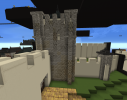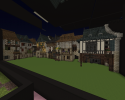R'hllor and Selyse's Circus
Regarding the religious devotion of the lords and knights in Stannis' camp, I would take all indication to devotion with a grain of salt for several reasons. The remaining lords and knights in the camp are way, waaay in over their heads in a very deep puddle of shit by the time they get to the wall.
It's very clear they are in a rough spot after the defeat on the Blackwater, and Stannis going to the Wall to save it isn't out of the good of his heart, but it's a political move to show the realm that contrary to the Lannisters, King Stannis does defend the realm from threads from outside; Stannis is the only one doing what the king is supposed to do. Several lords and knights are already looking for land and holdings in the North, indicating their prospects are pretty grim. The queen is surrounded by an especially toxic clique of supporters who appear to be very religious, but at the same time are very ambitious as well and sucking up to the queen and her faith is a good way to manouvre up the political ladder in Stannis' court.
Furthermore, the camp becomes increasingly toxicly religious over the course of the story. People are getting executed left and right as a sacrifice to R'hllor, in some cases because they speak against the sacrifices the Lord of Light apparantly demands. Not even the Queen's nephew and the strongest lord backing Stannis' cause is spared death by R'hllor. Being vocal about devotion to the god might be a way to armour yourself against accusations of being disloyal to "the cause".
It's likely to assume the Reachmen still with Stannis are trapped there rather than being there due to their love for the Lord of Light. Most of them joined Stannis when the vanguard of the Reach at Storms End went over to Stannis, who was technically the heir of Renly's fledgling kingdom so the Reach joining Stannis would have been a logical thing to happen. Mace joining with the Lannisters, which he was rebelling against, instead was an absolute wildcard nobody could have seen coming. When the news breaks Mace will not be joining Stannis half the Reach is already with him and cannot realistically back out. The only oppertunity they had to get back into the King's peace relatively unscathed was after the Battle of the Blackwater, an oppertunity they would have missed had they succesfully retreated from the battle. After the battle the lands of anyone still with Stannis are attainted, giving those lords and knights little choice but the go all in on Stannis.
They need to cling to Stannis, the faith and whatever comes with it because it's literally the only lifeline they have left. The remaining Reachmen in the camp have lost everything except their noble blood, and going along with Selyse's circus is a surefire way of keeping that blood at body temperature.
Foxglove architecture
I agree with Marge that the architecture chosen for this project does not seem to match the location the project is located in. Nearby projects (Oldtown, Uplands) rely on a more stone heavy palette with a Mediterranean architecture opposed to the still, even after the style update last sunday, quite timber frame heavy style you seem to be going for. I actually see little difference between the original tests and the updated ones. When Oldtown finally kicks off the style of the area will change drastically, and an outlier in style like this in the vicinity will make this project look outdated regardless of the quality of the build, purely because the style does not match the terrain, climate and culture as it is (being) established in the southern Reach and Honeywine area.
Regarding the stylistic connection with Dorne and your claim there is zero cultural exchange between the areas, I think that statement is wrong. The lack of a pass does not mean there is no way to get through the mountains. Robb for example manages to bypass the pass at the Golden Tooth with an entire army on tow, surely some traders, travellers and farmers can do the same in the Red Mountains. Additionally, the Dornish do not build the way they do out of cultural loyalty to the Rhoynish architectural influences found at, for example, the Tor. The people in the Red Mountains build the way they do because that is the most efficient way to do so, and this would not be much different on the other side of the ridge.
Earlier in the feedback proces you mention the tests were supposed to be for Norcross and the plans have been adapted to be applied at Foxglove, which is what I think Marge means with the statement of forcing the location to fit the tests. Each area of Westeros is unique, and in my humble opinion you shouldn't make tests and then look for a place to apply them since that means you are not using the geography, climate, economy and culture of the place you are applying for.
Gradient
I know this post is getting rather lengthy but I do want to point out one last thing, not neccesarily relative to this particular application since I have been seeing this at a lot more places.
The gradient for the castle seems to have splodges of Oldtown stone, which is something I've seen at several places (Maidenpool for example). What is the idea behind this? How did these splodges come to be? Is this type of gradient being applied because other places do it too or is there an actual phenomenon being portrayed that I am simply missing?
While it's true different hues of stone are used when building with natural stone, seeing them in patches like this is quite rare.
Mismatching stones can occur for a variety of reasons, such as different quarries or even different places within the same quarry, restaurative work with a different stone because the original can no longer be supplied or there being a cheaper alternative, or the state the stone is in (stone weathers over time). None of these reasons would result in patches of differently coloured stonework, unless for some reason these random patches degrade much faster than the rest of the masonry and have been repaired with new stone.
Differently coloured stone would be mixed while building resulting in a relatively monotonously coloured walls overall, or one or several layers would differ in colour altogether. Weathering often occurs at the base of the building, but since the floor is more often than not grass or dirt rather than cobbled or paved this would occur much slower or not at all in these buildings. Weathering also happens on top of buildings and outlying elements exposed to rain and wind, but that is rarely represented on the server.
In short, the patches of different stone is unrealistic and I am curious to know what the idea behind this is.

 docs.google.com
docs.google.com













